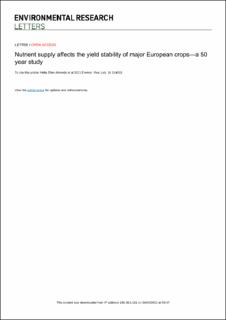| dc.contributor.author | Ahrends, Hella Ellen | |
| dc.contributor.author | Siebert, Stefan | |
| dc.contributor.author | Rezaei, Ehsan Eyshi | |
| dc.contributor.author | Seidel, Sabine Julia | |
| dc.contributor.author | Hüging, Hubert | |
| dc.contributor.author | Frank, Ewert | |
| dc.contributor.author | Döring, Thomas | |
| dc.contributor.author | Rueda-Ayala, Victor | |
| dc.contributor.author | Eugster, Werner | |
| dc.contributor.author | Gaiser, Thomas | |
| dc.date.accessioned | 2021-02-05T09:28:23Z | |
| dc.date.available | 2021-02-05T09:28:23Z | |
| dc.date.created | 2020-11-12T16:19:39Z | |
| dc.date.issued | 2020-12-18 | |
| dc.identifier.citation | Environmental Research Letters. 2020, 16 (1), . | en_US |
| dc.identifier.issn | 1748-9326 | |
| dc.identifier.uri | https://hdl.handle.net/11250/2726357 | |
| dc.description.abstract | Yield stability is important for food security and a sustainable crop production, especially under changing climatic conditions. It is well known that the variability of yields is linked to changes in meteorological conditions. However, little is known about the long-term effects of agronomic management strategies, such as the supply of important nutrients. We analysed the stability of four major European crops grown between 1955 and 2008 at a long-term fertilization experiment located in Germany. Six fertilizer treatments ranged from no fertilization over the omission of individual macronutrients to complete mineral fertilization with all major macronutrients (nitrogen, phosphorus, potassium and calcium). Yield stability was estimated for each crop x treatment combination using the relative yield deviation in each year from the corresponding (nonlinear) trend value (relative yield anomalies). Stability was lowest for potato, followed by sugar beet and winter wheat and highest for winter rye. Stability was highest when soils had received all nutrients with the standard deviation of relative yield anomalies being two to three times lower than for unfertilized plots. The omission of nitrogen and potassium was associated with a decrease in yield stability and a decrease in the number of simultaneous positive and negative yield anomalies among treatments. Especially in root crops nutrient supply strongly influenced both annual yield anomalies and changes in anomalies over time. During the second half of the observation period yield stability decreased for sugar beet and increased for winter wheat. Potato yields were more stable during the second period, but only under complete nutrient supply. The critical role of potassium supply for yield stability suggests potential links to changes in the water balance during the last decades. Results demonstrate the need to explicitly consider the response of crops to long-term nutrient supply for understanding and predicting changes in yield stability. | en_US |
| dc.language.iso | eng | en_US |
| dc.publisher | IOP Publishing | en_US |
| dc.rights | Navngivelse 4.0 Internasjonal | * |
| dc.rights.uri | http://creativecommons.org/licenses/by/4.0/deed.no | * |
| dc.title | Nutrient supply affects the yield stability of major European crops—a 50 year study | en_US |
| dc.type | Peer reviewed | en_US |
| dc.type | Journal article | en_US |
| dc.description.version | publishedVersion | en_US |
| dc.rights.holder | © 2020 The Author(s) | en_US |
| dc.source.pagenumber | 11 | en_US |
| dc.source.volume | 16 | en_US |
| dc.source.journal | Environmental Research Letters | en_US |
| dc.source.issue | 1 | en_US |
| dc.identifier.doi | 10.1088/1748-9326/abc849 | |
| dc.identifier.cristin | 1847481 | |
| dc.source.articlenumber | 014003 | en_US |
| cristin.ispublished | true | |
| cristin.fulltext | original | |
| cristin.qualitycode | 2 | |

